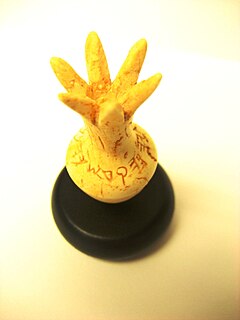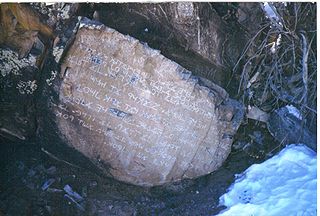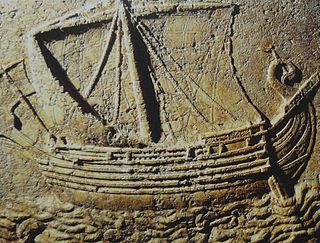 W
WThe Bat Creek inscription is an inscribed stone collected as part of a Native American burial mound excavation in Loudon County, Tennessee, in 1889 by the Smithsonian Bureau of Ethnology's Mound Survey, directed by entomologist Cyrus Thomas. The inscriptions were initially described as Cherokee, but in 2004, similarities to an inscription that was circulating in a Freemason book were discovered. Hoax expert Kenneth Feder says the peer reviewed work of Mary L. Kwas and Robert Mainfort has "demolished" any claims of the stone's authenticity. Mainfort and Kwas themselves state "The Bat Creek stone is a fraud."
 W
WThe Buyla inscription is a 9-word, 56-character inscription written in the Greek alphabet but in a non-Greek language. It is found on a golden buckled bowl or cup which is among the pieces of the Treasure of Nagyszentmiklós which are now in the Kunsthistorisches Museum in Vienna. The bowl is 12 cm in diameter and weighs 212 g, and has a handle or buckle, perhaps for hanging on a belt. The inscription is found around the outside of a circular design in the middle of the bowl. In the place where the inscription begins and ends, there is a cross. The inscription reads: ΒΟΥΗΛΑ·ΖΟΑΠΑΝ·ΤΕϹΗ·ΔΥΓΕΤΟΙΓΗ·ΒΟΥΤΑΟΥΛ·ΖΩΑΠΑΝ·ΤΑΓΡΟΓΗ·ΗΤΖΙΓΗ·ΤΑΙϹΗ.
 W
WThe ivory pomegranate is a thumb-sized semitic ornamental artifact acquired by the Israel Museum. It is not actually made of ivory, but of hippopotamus bone and bears an inscription; Holy (Sacred) to the Priest of the House of God (YHWH).
 W
WThe James Ossuary is a 1st-century limestone box that was used for containing the bones of the dead. An Aramaic inscription meaning "James (Jacob), son of Joseph, brother of Jesus" is cut into one side of the box. The ossuary attracted scholarly attention due to its apparent association with the Christian holy family. However, while the ossuary itself is accepted as authentic to the time period, the inscription itself has been declared by the Israeli Antiquities Authority to be a modern forgery.
 W
WThe Jordan Lead Codices,, are a collection of codices allegedly found in a cave in Jordan and first publicized in March 2011. A number of scholars and a November 2012 regional BBC News investigation have pronounced them fakes. In December 2016, a radioactivity test performed at the University of Surrey's Ion Beam Centre confirmed the old age of the lead used, but not the inscriptions. As of 2017, both the Israeli Antiquities Authority (IAA) and the Jordanian archaeological department regard them as forgeries.
 W
WThe Kafkania pebble is a small rounded river pebble about 5 centimetres (2.0 in) long, with Linear B symbols and a double axe symbol inscribed on it. It was found in Kafkania, some 7 km (4.3 mi) north of Olympia, on 1 April 1994 in a 17th-century BC archaeological context. If it were genuine, it would be the earliest writing on the Greek mainland, and by far the earliest document in Linear B. However, it is in all probability a modern forgery and a hoax.
 W
WThe Kensington Runestone is a slab of greywacke stone covered in runes that was allegedly discovered in central Minnesota in 1898. Olof Öhman, a Swedish immigrant, reported that he unearthed it from a field in the largely rural township of Solem in Douglas County. It was later named after the nearest settlement, Kensington.
 W
WThe runic inscription of debated authenticity discovered in the Kleines Schulerloch cave that was found in 1937, Altmühltal was not noticed until the 1950s. It readsbirg : leub : selbrade,
 W
WThe Los Lunas Decalogue Stone is a large boulder on the side of Hidden Mountain, near Los Lunas, New Mexico, about 35 miles (56 km) south of Albuquerque, that bears a very regular inscription carved into a flat panel. The stone is also known as the Los Lunas Mystery Stone or Commandment Rock. The stone is controversial in that some claim the inscription is Pre-Columbian, and therefore proof of early Semitic contact with the Americas.
 W
WThe Praeneste fibula is a golden fibula or brooch, today housed in the Museo Preistorico Etnografico Luigi Pigorini in Rome. The fibula bears an inscription in Old Latin, claiming craftsmanship by one Manios and ownership by one Numazios. At the time of its discovery in the late nineteenth century, it was accepted as the earliest known specimen of the Latin language. The authenticity of the inscription has since been disputed. However a new analysis performed in 2011 declared it to be genuine "beyond any reasonable doubt" and to date from the Orientalizing period, in the first half of the seventh century BC.
 W
WThe theory of Phoenician discovery of the Americas suggests that the earliest Old World contact with the Americas was not with Columbus or Norse settlers, but with the Phoenicians in the first millennium BC.
 W
WThe Toynbee tiles are messages of unknown origin found embedded in asphalt of streets in about two dozen major cities in the United States and four South American cities. Since the 1980s, several hundred tiles have been discovered. They are generally about the size of an American license plate, but sometimes considerably larger. They contain some variation of the following inscription:
 W
WThe Yarmouth Runic Stone, also known as the Fletcher Stone, is a slab of quartzite that first came to the attention of the public in the early 19th century. The stone appears to have an inscription carved into it, which some investigators, notably Henry Phillips, Jr., have interpreted as Norse runes. This has led to speculation that the Yarmouth, Nova Scotia area, in Canada, was visited by Viking explorers sometime around 1000 C.E. Many other theories have been put forward, including the possibility of a hoax or the inscription being a product of natural forces. The stone is currently on display at the Yarmouth County Museum.